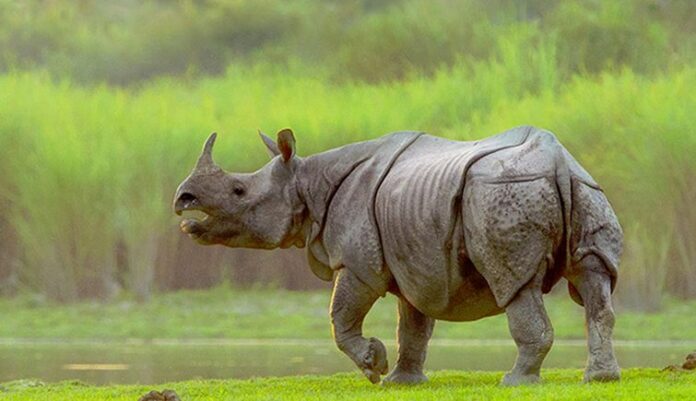Kaziranga National Park, renowned for its rich biodiversity and home to the largest population of one-horned rhinoceroses, has witnessed a remarkable 86% drop in rhino poaching incidents since 2016. A substantial victory for wildlife conservation is indicated by this drop, efforts, demonstrating the effectiveness of enhanced anti-poaching measures, government initiatives, and community engagement.
Located in the northeastern state of Assam, Kaziranga National Park is a UNESCO World Heritage Site and one of India’s most iconic wildlife sanctuaries. The park is home to a thriving population of the endangered one-horned rhinoceros, along with other wildlife species such as tigers, elephants, and wild water buffalo. However, for many years, poaching posed a serious threat to the rhino population in the park. Rhino horns, often sold in illegal markets, are highly sought after for their perceived medicinal properties in parts of Asia.
In response to this challenge, the Assam government and wildlife conservation authorities have implemented strict anti-poaching measures that have led to a significant reduction in rhino poaching over the past few years.
Kaziranga’s Fight Against Rhino Poaching
Rhino poaching in Kaziranga has been a grave concern for decades. In 2016, the national park saw its peak of poaching cases, where several rhinos were killed by poachers for their valuable horns. The demand for rhino horns in international markets, particularly in China and Vietnam, where they are falsely believed to have medicinal properties, spurred this illegal activity.
However, a combination of stringent enforcement measures, better surveillance, and the use of technology has drastically reduced poaching cases. According to reports, the number of poaching incidents dropped by 86% between 2016 and 2024, marking a victory in the ongoing battle against wildlife trafficking.
Government Initiatives and Anti-Poaching Efforts
The Assam government has played a pivotal role in curbing poaching activities in Kaziranga. In recent years, they have introduced several initiatives to bolster security in the park. Some of the key steps taken include:
- Increased Patrolling: The forest department has significantly increased patrolling in and around Kaziranga. More forest guards have been deployed to monitor sensitive areas, and patrols are conducted 24/7 to prevent illegal entry into the park.
- Technology-Driven Surveillance: Authorities have introduced the use of drones, thermal imaging cameras, and satellite surveillance to keep an eye on poaching hotspots. These technologies allow forest officials to monitor remote areas of the park where poachers are likely to operate.
- Intelligence Networks: Assam Police and the forest department have established intelligence networks that help in identifying and tracking down poachers. Collaborative efforts with national and international organizations have also helped in the arrest of notorious poachers.
- Community Involvement: Local communities play a crucial role in the conservation efforts of Kaziranga. The government has launched awareness programs to educate people living near the park about the importance of wildlife conservation and the need to protect endangered species. Community members are also involved in reporting suspicious activities to authorities.
- Swift Judicial Action: To ensure that poachers are not easily released, the government has enacted strict laws and pushed for swift judicial action. Those caught engaging in poaching activities face severe penalties, including imprisonment and hefty fines.
Impact on Rhino Population
The drop in poaching has had a direct impact on the rhino population in Kaziranga. The park is now home to over 2,400 one-horned rhinos, the highest concentration of this species in the world. Due to the concerted efforts to protect these animals, the rhino population has steadily increased over the years, reaffirming Kaziranga’s status as a global success in wildlife conservation.
The sharp decline in poaching has not only benefited the rhinos but also enhanced the overall ecosystem of the park. With less poaching, other species such as tigers, elephants, and swamp deer have flourished, leading to a more balanced and thriving environment.
Kaziranga’s success in reducing poaching has earned it global recognition. Conservationists around the world have lauded the efforts of the Assam government and forest officials for their dedication to protecting endangered species. Kaziranga’s model of community involvement, technology-driven surveillance, and strict enforcement is now being studied by other countries facing similar wildlife challenges.
However, challenges remain. While the drop in poaching is a major milestone, it is important to maintain vigilance. Poachers are constantly evolving their tactics, and there is a need for continued investment in technology, intelligence, and community engagement to ensure that poaching remains under control.
The 86% drop in rhino poaching in Kaziranga National Park since 2016 is a testament to the power of collaboration between government agencies, conservation organizations, and local communities. With continued efforts and innovative strategies, Kaziranga is well on its way to securing the future of the endangered one-horned rhinoceros and maintaining its status as a world-renowned wildlife sanctuary.




